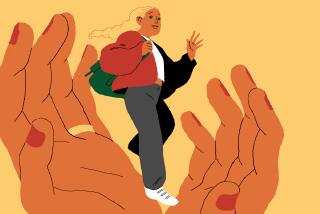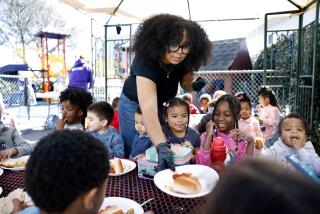‘90s FAMILY : Someone to Lean On : Some people think that older kids can look after themselves. But experts--and now, more parents--say the support children get in the preteen and teen years may be more important to their development than the care they received before kindergarten.
- Share via
For Moira Feingold, it was the nightmares her 7-year-old was having. For Lynda Humphreville, it was the prospect of her ninth-grader being home alone for the summer while she worked. Feingold quit her job; Humphreville found a new one that gave her summers and afternoons off.
Both moms confronted the fact that child-care problems don’t go away once kids are in school. Indeed, some parents and experts argue that the care children get during middle school through high school is even more crucial to their development than the care children receive prior to kindergarten.
“When my kids were babies, I found that as long as they had a loving caregiver who took care of their physical needs and played with them, they were OK,” said Feingold, a 44-year-old Santa Monica mom, who left her demanding job as a hospital vice president when her boys were 3 and 7 to be home for them.
“When they got older and out in the world, they really needed me. Not just to ferry them around to sports and religious school, but to help them make sense of their encounters. They were no longer in the safe cocoon of the home, but were running into the problems of the world.”
Feingold’s older son, then 7, had begun having nightmares that a child psychiatrist interpreted as the son believing Feingold was abandoning him. That was it. Feingold didn’t work at all for three years. Now that her children are 10 and 14, she works part-time as a consultant, arranging her hours so that she’s home when they are.
Linda Calvin, a child development specialist, said she often sees similar family struggles in her position as coordinator of pupil services for Conejo Valley Unified School District and as a family therapist in private practice, although she emphasizes that not all kids have the same needs nor are they impacted the same way when both parents work.
“Nonetheless,” she said, “all kids need someone against whom they can play out the ideas and thoughts of the day, a person with whom they can check out what they’ve learned. If no mentor is available to them, or if the caretaker is indifferent, too busy or absent, then kids come up with their own notions of right, wrong and reality. Left to their own devices, children can become misguided and experience abandonment.”
Humphreville, a 44-year-old schoolteacher who lives in Vista, has worked full-time since her children were born. She went back to work just six weeks after her youngest son, now 10, was born, leaving him in the same capable hands of the woman who had cared for her daughter, five years older.
Once her kids were in school, she was home by 3:30 p.m., just an hour after they were. The schedules meshed until last year, when her daughter moved from a year-round school into one with a traditional calendar. While both kids were in year-round school, Humphreville’s job teaching emotionally disturbed children in a residential treatment center had worked out. A parks and recreation program filled in the gaps when the kids were off and she was working.
But when Humphreville’s daughter became a freshman in high school, “I didn’t like the idea of her spending all summer at home by herself. She’s a good kid, but even good kids left to their own devices get in trouble,” she said. So Humphreville applied to teach in a public school with a traditional calendar. She now picks up her son from the fifth grade every day at 2:30 p.m. and has summers and all school holidays off.
“I probably feel stronger than most mothers about the importance of being home for my kids,” Humphreville said, “because I teach severely emotionally disturbed kids. So many of these kids have little parental support. I see them get into trouble that they just wouldn’t have if a parent were more involved. They come to school with so much baggage that we have to sort out before any real learning is done. That sorting should happen in the home.”
*
Although Humphreville and Feingold have arranged to be the ones at home, Calvin said the person who cares for the child after school doesn’t have to be a parent. “For healthy developmental, emotional and social development, children need, if not a parent, a surrogate parent or mentor with whom they can have one-on-one contact. This person will be highly tied to the child’s development.”
What Calvin doesn’t like to see is the classic latchkey situation, where children are left on their own after school until 7 p.m. every weeknight. “The latchkey kids often watch a lot of unsupervised television. Left on their own to interpret, they can come up with very distorted images of the way things are.”
Similarly, she thinks that kids who spend after-school hours in day care with 20 or 30 other children miss out on an important human connection. The connectedness she’s talking about is the time when cultures, values and beliefs are passed on.
“That doesn’t mean you can’t be gone until 7 p.m. once in a while, or not be home one afternoon,” Calvin said. “As a parent, you need to look at the overall length of time you are habitually absent, the quality of the time you spend with your children, and who’s filling in when you’re gone.”
Ron Kotkin, director of day treatment programs at the Child Development Center at the UC Irvine Department of Pediatrics, concurs. “In the long haul, what will be significant is what parents have modeled over time. Modeling is an extremely strong component of how children learn. If they’re going to learn significant moral development, then the parents need to be there to model. If parents are absent, kids choose other models.”
Kids look and act so grown-up today, he added, that many parents of pre-adolescents and adolescents tend to back away. “But these kids are still so young emotionally. Parents need to be there as much then if not more. If parents and kids develop a good relationship at the outset, then teen-age turmoil will be much easier to go through.”
*
Humphreville knows that firsthand: “My daughter is now 15 going on 21. Her big thing is having her friends over after school. If I weren’t home, I wouldn’t let her. Then she’d go to someone else’s house. I like knowing she’s home and that she can have her friends here. At least I know what’s happening.”
Feingold concedes that for the years she worked, she didn’t always realize what was happening.
“When I used to work until 6 p.m., we just didn’t have the same opportunities for closeness,” she said. “Between 6 p.m. and 9 p.m. there was always this rush of dinner, dishes, finishing homework, maybe half an hour of television, a book, then bed. I realized only later what I’d been missing between the hours of 3:30 p.m. and 5:30 p.m.
“It’s then, when the kids are doing their homework that their homework triggers a memory of something that happened at school, which they share then and there. That just doesn’t surface after 6 p.m. unless it’s something really traumatic,” she said. “Not missing those times has been worth anything I gave up.”
More to Read
Sign up for Essential California
The most important California stories and recommendations in your inbox every morning.
You may occasionally receive promotional content from the Los Angeles Times.










